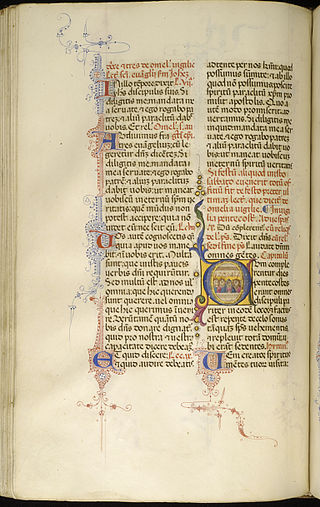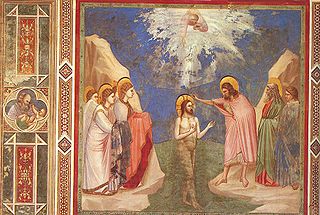Related Research Articles

The Roman Breviary is a breviary of the Roman Rite in the Catholic Church. A liturgical book, it contains public or canonical prayers, hymns, the Psalms, readings, and notations for everyday use, especially by bishops, priests, and deacons in the Divine Office.

The Roman Missal is the title of several missals used in the celebration of the Roman Rite. Along with other liturgical books of the Roman Rite, the Roman Missal contains the texts and rubrics for the celebration of the most common liturgy and Mass of the Catholic Church.

The liturgical year, also called the church year, Christian year or kalendar, consists of the cycle of liturgical seasons in Christian churches that determines when feast days, including celebrations of saints, are to be observed, and which portions of Scripture are to be read either in an annual cycle or in a cycle of several years.

The Tridentine Mass, also known as the Traditional Latin Mass or the Traditional Rite, is the liturgy in the Roman Missal of the Catholic Church codified in 1570 and published thereafter with amendments up to 1962. Celebrated almost exclusively in Ecclesiastical Latin, it was the most widely used Eucharistic liturgy in the world from its issuance in 1570 until the introduction of the Mass of Paul VI.
A memorial in the Roman Rite of the Catholic Church is a lower-ranked feast day in honour of a saint, the dedication of a church, or a mystery of the religion.

The Feast of the Baptism of the Lord, or Theophany, is the feast day commemorating the baptism of Jesus in the Jordan River by John the Baptist. Originally the baptism of Christ was celebrated on Epiphany, which commemorates the coming of the Magi, the baptism of Christ, and the wedding at Cana. Over time in the West, however, the celebration of the baptism of the Lord came to be commemorated as a distinct feast from Epiphany. It is celebrated in the Catholic Church as well as the Anglican and Lutheran Churches on the first Sunday following The Epiphany of Our Lord. Some Lutheran churches celebrate it on the Sunday before Lent, or Quinquagesima.

The Introit is part of the opening of the liturgical celebration of the Eucharist for many Christian denominations. In its most complete version, it consists of an antiphon, psalm verse and Gloria Patri, which are spoken or sung at the beginning of the celebration. It is part of the proper of the liturgy: that is, the part that changes over the liturgical year.

A missal is a liturgical book containing instructions and texts necessary for the celebration of Mass throughout the liturgical year. Versions differ across liturgical tradition, period, and purpose, with some missals intended to enable a priest to celebrate Mass publicly and others for private and lay use. The texts of the most common Eucharistic liturgy in the world, the Catholic Church's Mass of Paul VI of the Roman Rite, are contained in the 1970 edition of the Roman Missal.

The Liturgy of the Hours, Divine Office, or Opus Dei are a set of Catholic prayers comprising the canonical hours, often also referred to as the breviary, of the Latin Church. The Liturgy of the Hours forms the official set of prayers "marking the hours of each day and sanctifying the day with prayer." The term "Liturgy of the Hours" has been retroactively applied to the practices of saying the canonical hours in both the Christian East and West–particularly within the Latin liturgical rites–prior to the Second Vatican Council, and is the official term for the canonical hours promulgated for usage by the Latin Church in 1971. Before 1971, the official form for the Latin Church was the Breviarium Romanum, first published in 1568 with major editions through 1962.

An antiphonary or antiphonal is one of the liturgical books intended for use in choro, and originally characterized, as its name implies, by the assignment to it principally of the antiphons used in various parts of the Latin liturgical rites.
The Use of York or York Rite was a liturgical use of the Roman Rite – itself a Latin liturgical rite – practised in part of northern England, prior to the reign of Henry VIII. During Henry's reign the Use of York was suppressed in favour of the Use of Sarum, developed at Salisbury Cathedral, followed by the Book of Common Prayer. "Use" denotes the special liturgical customs which prevailed in a particular diocese or group of dioceses; it is one of the medieval English uses, together with the Use of Sarum, the Use of Hereford, and the Use of Bangor.
The text and rubrics of the Roman Canon have undergone revisions over the centuries, while the canon itself has retained its essential form as arranged no later than the 7th century. The rubrics, as is customary in similar liturgical books, indicate the manner in which to carry out the celebration.
A Catholic order liturgical rite is a variant of a Catholic liturgical rite distinct from the typical ones, such as the Roman Rite, but instead specific to a certain Catholic religious order.
The reform of the Roman Breviary by Pope Pius X was promulgated by that Pope with the apostolic constitution Divino afflatu of 1 November 1911.

The Mass of the Lord's Supper, also known as A Service of Worship for Maundy Thursday, is a Holy Week service celebrated on the evening of Maundy Thursday. It inaugurates the Easter Triduum, and commemorates the Last Supper of Jesus with his disciples, more explicitly than other celebrations of the Mass.

Agapitus is venerated as a martyr saint, who died on August 18, perhaps in 274, a date that the latest editions of the Roman Martyrology say is uncertain.

The liturgical books of the Roman Rite are the official books containing the words to be recited and the actions to be performed in the celebration of Catholic liturgy as done in Rome. The Roman Rite of the Latin or Western Church of the Catholic Church is the most widely celebrated of the scores of Catholic liturgical rites. The titles of some of these books contain the adjective "Roman", e.g. the "Roman Missal", to distinguish them from the liturgical books for the other rites of the Church.
The ranking of liturgical days in the Roman Rite is a regulation for the liturgy of the Roman Catholic church. It determines for each liturgical day which observance has priority when liturgical dates and times coincide, which texts are used for the celebration of the Holy Mass and the Liturgy of the hours and which liturgical color is assigned to the day or celebration.
The Code of Rubrics is a three-part liturgical document promulgated in 1960 under Pope John XXIII, which in the form of a legal code indicated the liturgical and sacramental law governing the celebration of the Roman Rite Mass and Divine Office.
Rubricarum instructum is an apostolic letter of Pope John XXIII issued motu proprio on July 25, 1960 promulgating the new Code of Rubrics for both the Roman Breviary and the Roman Missal.
References
- ↑ Patrick Morrisroe, "Commemoration (in Liturgy)" in Catholic Encyclopedia (New York, New York, USA; 1908)
- ↑ Cum nostra hac aetate, 3, 5,
- ↑ Adrian Fortescue, "Collect" in Catholic Encyclopedia (New York, 1908)
- ↑ Breviarium Romanum ex Decreto Sacrosancti Concilii Tridentini restitutum Apud Paulum Manutium, Roma 1568. Facsimile: Achille Maria Triacca, Breviarium Romanum. Editio princeps (1568), Libreria Editrice Vaticana, Città del Vaticano 1999
- ↑ Missale Romanum ex Decreto Sacrosancti Concilii Tridentini restitutum Pii V. Pont. Max. editum Apud haeredes Bartholomaei Faletti, Ioannem Varisei et socios, Roma 1570. Facsimile: Manlio Sodi, Antonio Maria Triacca, Missale Romanum. Editio princeps (1570), Libreria Editrice Vaticana, Città del Vaticano 1998.
- ↑ Missale Romanum, 1920 typical edition, pp. 39*–40*
- ↑ Missale Romanum, 1920 typical edition, pp. 40*–41*
- ↑ Cum nostra hac aetate, 5, 1.
- ↑ Missale Romanum, 1920 typical edition, pp. 54*–58*
- ↑ Acta Apostolicae Sedis 47 (1955), pages 218–24.
- ↑ Cum nostra hac aetate, 2.
- ↑ Cum nostra hac aetate, 3, 1.
- ↑ Cum nostra hac aetate, 4, 11.
- ↑ Cum nostra hac aetate, 3, 2–3.
- ↑ Cum nostra hac aetate, 3, 5.
- ↑ Ordo Divini Officii Recitandi Sacrique Peragendi Archived 2017-08-09 at the Wayback Machine , p. 27.
- ↑ General Instruction of the Roman Missal , 355.
- ↑ Apostolic Constitution Laudis canticum promulgating the Divine Office as revised in accordance with the decree of the Second Ecumenical Council of the Vatican.
- ↑ General Introduction of the Liturgy of the Hours, 239.
- ↑ Edward McNamara, "Antiphons of Commemorations".
- ↑ Universal Norms on the Liturgical Year and the Calendar, 60.